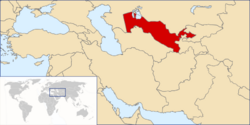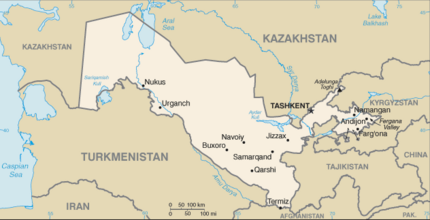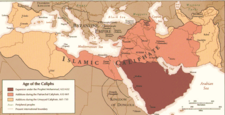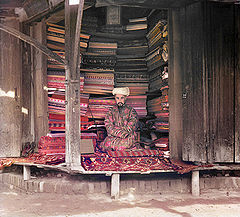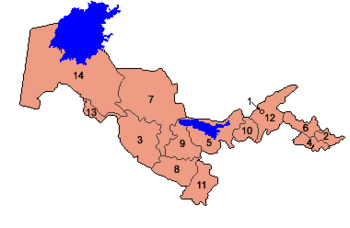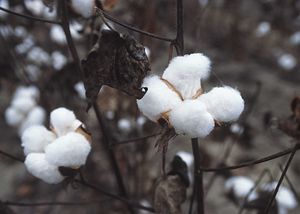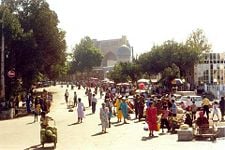Uzbekistan
| O‘zbekiston Respublikasi O‘zbekiston Jumhuriyati Ўзбекистон Республикаси Republic of Uzbekistan | |||||
| |||||
| Motto: none | |||||
| Anthem: National Anthem of the Republic of Uzbekistan | |||||
| Capital (and largest city) |
Tashkent 41°16′N 69°13′E | ||||
| Official languages | Uzbek | ||||
|---|---|---|---|---|---|
| Government | Authoritarian republic | ||||
| - President | Islom Karimov | ||||
| - Prime Minister | Shavkat Mirziyoyev | ||||
| Independence | from the Soviet Union | ||||
| - Formation | 1747, as Bukharian Emirate, Kokand Khanate, Khwarezm | ||||
| - Declared | September 1 1991 | ||||
| - Recognized | December 8 1991 | ||||
| - Completed | December 25 1991 | ||||
| Area | |||||
| - Total | 447,400 km² (56th) 172,742 sq mi | ||||
| - Water (%) | 4.9 | ||||
| Population | |||||
| - July 2005 estimate | 26,593,000 | ||||
| - Density | 59/km² 153/sq mi | ||||
| GDP (PPP) | 2005 estimate | ||||
| - Total | $50.395 billion | ||||
| - Per capita | $1,920 | ||||
| HDI (2003) | 0.694 (medium) | ||||
| Currency | Uzbekistani som (UZS)
| ||||
| Time zone | UZT (UTC+5) | ||||
| - Summer (DST) | not observed (UTC+5) | ||||
| Internet TLD | .uz | ||||
| Calling code | +998 | ||||
Uzbekistan, officially the Republic of Uzbekistan, is a doubly-landlocked country in Central Asia, formerly of the Soviet Union, surrounded entirely by other landlocked states.
Located in the heart of Central Asia between the Amu Darya (Oxus) and Syr Darya (Jaxartes) Rivers, Uzbekistan' has a long and interesting heritage. The leading cities of the Silk Road - Samarkand, Bukhara, and Khiva - are located in Uzbekistan.
But the heavy use of agrochemicals, diversion of huge amounts of irrigation water from the two rivers that feed the region, and the chronic lack of water treatment plants have caused health and environmental problems on an enormous scale.
Geography
The name Uzbek, both for the people and for the nation itself, is said to be self-referential from the period the Russians first encountered the people, parsing as ozum bek, or "I am the lord (or ruler)". The word ozbek means “real”, “original”, or “true”. The word “oz” means “leader” and “bek” means “noble”.
Bordering Turkmenistan to the southwest, Kazakhstan and the Aral Sea to the north, and Tajikistan and Kyrgyzstan to the south and east, Uzbekistan is not only one of the larger Central Asian states but also the only Central Asian state to border all of the other four. Uzbekistan also shares a short border with Afghanistan to the south.
With a land area of 172,700 square miles, (447,400 square kilometres, Uzbekistan is approximately the size of Morocco or California, and is the 56th-largest country (after Sweden). Uzbekistan stretches 885 miles (1425 km) from west to east and 578miles (930km) from north to south.
Uzbekistan is a dry, country of which 10 percent consists of intensely cultivated, irrigated river valleys. It is one of two double-landlocked countries in the world (the other being Liechtenstein) although Uzbekistan has borders with two countries (Kazakhstan in the north and Turkmenistan in the south) bordering the landlocked but non-freshwater Caspian Sea from which ships can reach the Sea of Azov and thus the Black Sea, the Mediterranean Sea and the oceans.
The physical environment ranges from the flat, desert topography that comprises almost 80 percent of the country territory to mountain peaks in the east. The highest point is Adelunga Togh at 14,111 feet (4301 meters) above sea level
Southeastern Uzbekistan is characterized by the foothills of the Tian Shan mountains, which form a natural border between Central Asia and China. The vast Qizilqum ("red sand") Desert, shared with southern Kazakstan, dominates the northern lowland region. The most fertile part of Uzbekistan, the Fergana Valley, is an area of about 21,440 square kilometers directly east of the Qizilqum and surrounded by mountain ranges to the north, south, and east. The western end of the valley is defined by the course of the Syr Darya, which runs across the northeastern sector of Uzbekistan from southern Kazakstan into the Qizilqum.
Water resources are unevenly distributed, and in short supply in most of Uzbekistan. The vast plains that occupy two-thirds of Uzbekistan's territory have little water, and there are few lakes. The two largest rivers are the Amu Darya and the Syr Darya, which originate in the mountains of Tajikistan and Kyrgyzstan, respectively.
The mountain areas are especially prone to earthquakes. Indeed, much of Uzbekistan's capital city, Tashkent, was destroyed in a major earthquake in 1966, and other earthquakes have caused significant damage before and since the Tashkent disaster.
Uzbekistan climate has a continental climate, with hot summers and cool winters. Summer temperatures often surpass 104°F (40°C), while winter temperatures average about –9.4°F (-23°C), but may fall as low as -40°C. Most of the country also is quite arid, with average annual rainfall amounting to between four and eight inches (100 and 200 millimeters) and occurring mostly in winter and spring. Between July and September, little precipitation falls, essentially stopping the growth of vegetation during that period.
Fauna include the extremely rare Saiga antelope] (Saiga tatarica) and a large lizard Desert monitor) that can reach lengths of five feet (1.6 meters), the Bukhara Deer (a local species of Cervus elaphus), wild boar (Sus scrofa), pheasant (Phasianus colchicus), golden eagle (Aquila chrysaetus)

But the heavy use of agrochemicals, diversion of huge amounts of irrigation water from the two rivers that feed the region, and the chronic lack of water treatment plants have caused health and environmental problems on an enormous scale.
The most visible damage has been to the Aral Sea, which in the 1970s was larger than most of the Great Lakes of North America. Sharply increased irrigation caused the sea to shrink. By 1993, the Aral Sea had lost an estimated 60 percent of its volume, and was breaking into three unconnected segments. Increasing salinity and reduced habitat killed the fish, destroying its fishing industry. The depletion of this large body of water has increased temperature variations in the region, which has harmed agriculture.
Every year, many tons of salt and dust from the sea's dried bottom are carried as far as 800 kilometers away, and has led to the large-scale loss of plant and animal life, loss of arable land, changed climatic conditions, depleted yields on the cultivated land that remains, and destruction of historical and cultural monuments.
In addition, decades of poor water management and lack of water or sewage treatment plants, heavy use of pesticides, herbicides, defoliants, and fertilizers in the fields, and construction of industrial enterprises without regard to human or environmental impact present enormous environmental challenges throughout Uzbekistan.
In the early 1990s, about 60 percent of pollution control funding went to water-related projects, but only about half of cities and about one-quarter of villages have sewers. Communal water systems do not meet health standards; much of the population lacks drinking water systems and must drink water straight from contaminated irrigation ditches, canals, or the Amu Darya itself. According to one report, virtually all the large underground fresh-water supplies in Uzbekistan are polluted by industrial and chemical wastes.
Fewer than half of factory smokestacks in Uzbekistan are equipped with filtration devices, and none has the capacity to filter gaseous emissions. In addition, a high percentage of existing filters are defective or out of operation.
The government of Uzbekistan has acknowledged the extent of the country's environmental problems, and it has made a commitment to address them in its Biodiversity Action Plan. But the governmental structures to deal with these problems remain confused and ill defined.
Tashkent is the capital of Uzbekistan and also of Tashkent Province. The population of the city in 2006 was 1,967,879.
History
The territory of Uzbekistan was populated in the second millennium B.C.E. There are findings of early human’s tools and monuments in the Ferghana, Tashkent, Bukhara, Khorezm (Khwarezm, Chorasmia), Samarkand regions.
The first civilizations to appear in Uzbekistan were Sogdiana, Bactria and Khwarezm (Chorasmia). Territories of these states became a part of Persian Achaemenid empire in the sixth century B.C.E.
Alexander the Great conquered Sogdiana and Bactria in 327 B.C.E., marrying Roxane, daughter of a local Sogdian chieftain. However, the conquest was of little help to Alexander as popular resistance was fierce; causing Alexander's army to be bogged down in the region.
The territory of Uzbekistan was referred to as Transoxiana until the eighth century]]. See also: Sogdiana
Middle Ages
Muslim Arabs conquered the area in the eighth century C.E. A century later, the Persian Samanid dynasty established an empire, and encouraged Persian culture in the area. Later, the Samanid empire was overthrown by the Kara-Khanid Khanate. Uzbekistan and rest Central Asia was invaded by Jenghis Khan and his Mongol tribes in 1220.
In the 1300s, Timur (1336 - 1405), known in the west as Tamerlane, overpowered the Mongols and built his own empire. In his military campaigns, Tamerlane reached as far as the Middle East. He defeated Ottoman Emperor Bayezid I and rescued Europe from Turkish conquest.
Tamerlane sought to build a capital of his empire in Samarkand. From each campaign he would send artisans to the city, sparing their lives. Samarkand became home for many people; there used to be Greek and Chinese, Egyptian and Persian, Syrian and Armenian neighborhoods. Uzbekistan's most noted tourist sights date from the Timurid dynasty.
Later, separate Muslim city-states emerged with strong ties to Persia.
Russian influence
At the start of the nineteenth century, there were some 2000 miles (3200km) separating British India and the outlying regions of the Imperial Russia. Much of the land in between was unmapped. At that time, the Russian Empire began to expand, and spread into Central Asia. The "Great Game" period, of rivalry and strategic conflict between the British Empire and the Tsarist Russian Empire for supremacy in Central Asia, is generally regarded as running from approximately 1813 to the Anglo-Russian Convention of 1907.
In 1865, Russia occupied Tashkent and by the end of the nineteenth century, Russia had conquered all of Central Asia. In 1876, the Russians dissolved the Khanate of Kokand, while allowing the Khanate of Khiva and the Emirate of Bukhara to remain as direct protectorates. Russia placed the rest of Central Asia under colonial administration, and invested in the development of Central Asia's infrastructure, promoting cotton growing, and encouraging settlement by Russian colonists.
By the beginning of the twentieth century, Central Asia was firmly in the hands of Russia and despite some early resistance to Bolsheviks, Uzbekistan and the rest of Central Asia became a part of the Soviet Union.
Though stiff resistance to the Red Army after World War I was eventually suppressed, resistance groups called basmachi operated in the region reaching as far as the Pamir Mountains until the 1930s.
Soviet rule
In 1924 following the establishment of Soviet rule, the Uzbek Soviet Socialist Republic was created from ethnic Uzbek areas of Central Asia, including most of the territories of the Emirate of Bukhara and Khanate of Khiva as well as portions of the Fergana Valley that had constituted the Khanate of Kokand.
During the Soviet era, Moscow used Uzbekistan for its tremendous cotton-growing ("white gold"), grain, and natural resource potential. The extensive and inefficient irrigation used to support the former has been the main cause of shrinkage of the Aral Sea to less than one-third of its original volume, making this one of the world's worst environmental disasters. The overuse of agrochemicals and the depletion of the water supply have left large parts of the land poisoned.
President Islom Kharimov, who became the Communist Party's First Secretary in Uzbekistan in 1989, became president of the Uzbek Soviet Socialist Republic in March 1990.
On April 7, 1990, the Soviet Union passed a law allowing republics to leave the union if two thirds of their voters wished to. On August 31, 1991, Uzbekistan reluctantly declared independence, marking September 1 as a national holiday. In subsequent ethnic tensions, two million Russians left the country for Russia.
The country now seeks to gradually lessen its dependence on agriculture - it is the world's second-largest exporter of cotton - while developing its mineral and petroleum reserves. While departing from communism, Karimov has retained authoritarian control over the independent state.
Government and politics
The politics of Uzbekistan take place in the framework of a presidential republic, whereby the president is chief of state. The nature of government is authoritarian presidential rule, with little power outside the executive branch. The president is elected by popular vote for a seven-year term, and is eligible for a second term. The year 2007 was to be an election year.
The president appoints the prime minister, a cabinet of ministers, and their deputies. The Supreme Assembly approves the.cabinet.
The bicameral Supreme Assembly or Oliy Majlis consists of a senate of 100 seats. Regional governing councils elect 84 members to serve five-year terms, and the president appoints 16. The legislative chamber comprises 120 seats. Members are elected by popular vote to serve five-year terms. Elections were last held in 2004.
President Islom Kharimov's Halq Tarakiati Partiiasi, or People's Democratic Party, controls all aspects of governance. All parties in the Supreme Assembly support President Kharimov.
Although the constitution requires independent judges, the judicial system lacks independence. Supreme Court judges are nominated by the president and confirmed by the Supreme Assembly. The legal system is an evolution of Soviet civil law. Defendants are seldom acquitted, and if they are, the government can appeal. Reports of police abuse and torture are widespread. People are reluctant to call the police, as they are not trusted. Petty crime has become more common, while violent crime is more rare. Although police are tough on drug abuse, heroin use has increased since it is available. Heroin is shipped through Uzbekistan from Afghanistan and Pakistan to Europe.
Uzbekistan is divided into 12 provinces or viloyat, one autonomous republic, and one independent city.
Toshkent City, 1; Andijan Province, 2; Buxoro Province, 3; Fergana Province, 4; Jizzax Province, 5; Xorazm Province, 13; Namangan Province, 6; Navoiy Province, 7; Qashqadaryo Province, 8; Karakalpakstan Republic, 14; Samarqand Province, 9; Sirdaryo Province, 10; Surxondaryo Province, 11; Toshkent Province, 12.
Enclaves and exclaves
An “enclave” is a country or part of a country mostly surrounded by the territory of another country or wholly lying within the boundaries of another country, and an “exclave” is one that is geographically separated from the main part by surrounding alien territory. There are four Uzbek exclaves, all of them surrounded by Kyrgyz territory in the Fergana Valley region where Kyrgyzstan, Tajikistan and Uzbekistan meet.
Exclaves include: Sokh, with an area of 125 square miles (325km²) and a population of 42,800 in 1993, comprises 99 percent Tajiks and the remainder Uzbeks; Shakhrimardan (also known as Shakirmardon or Shah-i-Mardan), with an area of 35 square miles (90km²) and a population of 5100 in 1993, comprises 91 percent Uzbeks and the remainder Kyrgyz; Chong-Kara (or Kalacha), on the Sokh river, between the Uzbek border and Sokh, is.roughly two miles (3km) long by 0.6 miles (1km) wide; and Dzhangail, a dot of land barely 1.5 miles (2 or 3km) across.
Uzbekistan has a Tajikistan enclave, the village of Sarvan, which includes a narrow, long strip of land about nine miles (15km) long by 0.6 miles (1km) wide, alongside the road from Angren to Kokand. There is also a tiny Kyrgyzstan enclave, the village of Barak (population 627), between the towns of Margilan and Fergana.
Military
Uzbekistan possesses the largest military force in the Central Asian region, having around 65,000 people in uniform. Its structure is inherited from the Soviet armed forces, although it is moving rapidly toward a fully restructured organization, which will eventually be built around light and Special Forces. The Uzbek Armed Forces' equipment is not modern, and training, while improving, is neither uniform nor adequate for its new mission of territorial security. The government has accepted the arms control obligations of the former Soviet Union, acceded to the Nuclear Non-Proliferation Treaty (as a non-nuclear state), and supported an active program by the U.S. Defense Threat Reduction Agency (DTRA) in western Uzbekistan (Nukus and Vozrozhdeniye Island). The Government of Uzbekistan spends about 3.7 percent of GDP on the military but has received a growing infusion of Foreign Military Financing (FMF) and other security assistance funds since 1998. Uzbekistan approved the U.S. Central Command's request for access to a vital military air base, Karshi-Khanabad, in southern Uzbekistan following the September 11, 2001 terrorist attacks in the U.S. After the Andijan riot and subsequent U.S. reaction, Uzbekistan demanded that the U.S. withdraw from the airbases. The last US troops left Uzbekistan in November 2005.
Foreign relations
Uzbekistan joined the Commonwealth of Independent States in December 1991. However, it is opposed to reintegration and withdrew from the CIS collective security arrangement in 1999. Since that time, Uzbekistan has participated in the CIS peacekeeping force in Tajikistan and in UN-organized groups to help resolve the Tajik and Afghan conflicts, both of which it sees as posing threats to its own stability.
Previously close to Washington (which gave Uzbekistan half a billion dollars in aid in 2004, about a quarter of it military), the government of Uzbekistan has restricted American military use of the airbase at Karshi-Khanabad which is used for air operations in neighboring Afghanistan.
Uzbekistan was an active supporter of U.S. efforts against worldwide terrorism and joined the coalitions that have dealt with both Afghanistan and Iraq. The relationship between Uzbekistan and the United States began to deteriorate after the so-called "color revolutions" in Georgia and Ukraine (and to a lesser extent Kyrgystan). When the U.S. joined in a call for an independent international investigation of the bloody events at Andijon, the relationship took an additional nosedive and President Islam Karimov changed the political alignment of the country closer to Russia and China, countries that chose not to criticize Uzbekistan's leaders for the alleged human rights violations.
It is a member of the United Nations, the Euro-Atlantic Partnership Council, Partnership for Peace, and the Organization for Security and Cooperation in Europe (OSCE). It belongs to the Organization of the Islamic Conference and the Economic Cooperation Organization—comprising the five Central Asian countries, Azerbaijan, Turkey, Iran, Afghanistan, and Pakistan. Uzbekistan is also a member of the Shanghai Cooperation Organization and hosts the SCO’s Regional Anti-Terrorist Structure (RATS) in Tashkent. Uzbekistan also joined the new Central Asian Cooperation Organization (CACO) in 2002. The CACO consists of Uzbekistan, Tajikistan, Kazakhstan, and Kyrgyzstan. It is a founding member of the Central Asian Union, formed with Kazakhstan and Kyrgyzstan, joined in March, 1998, by Tajikistan.
Economy
Uzbekistan is a dry, landlocked country of which 11 percent consists of intensely cultivated, irrigated river valleys. More than 60 percent of its population lives in densely populated rural communities. Uzbekistan is now the world's second-largest cotton exporter and fifth largest producer. It relies heavily on cotton production as the main source of export earnings. Other major export earners include gold, natural gas, and oil.
Agriculture contributes about 37 percent of GDP while employing 44 percent of the labor force. Unemployment and underemployment are estimated to be at least 20 percent.
Following independence in September 1991, the government sought to prop up its Soviet-style command economy with subsidies and tight controls on production and prices. While aware of the need to improve the investment climate, the government still sponsors measures that often increase, not decrease, its control over business decisions.
After independence, Uzbekistan moved to private property ownership. From 1992, Uzbekistanis were able to buy their homes from the state for the equivalent of three months' salary. Ownership of agricultural land, which had been state-owned during the Soviet period, has been assumed by the families or communities that farmed the land. The new owners are still subject to state controls. About 60 percent of small businesses and services are privately owned. Large factories remain state-owned.
The economic policies have repelled foreign investment, which is the lowest per capita in the Commonwealth of Independent States.
Inflation, though lower than in the mid-1990s, remained high up until 2003 (estimated 50 percent in 2002, 21.9 percent in 2003. Tight economic policies in 2004 resulted in drastic reduction of inflation, to 3.8 percent (while alternative estimates based on price of true market basket, put it at 15 percent).
A sharp increase in the inequality of income distribution has hurt the lower ranks of society since independence. In 2003, the government accepted the obligations of Article VIII under the International Monetary Fund (IMF), providing for full currency convertibility. However, strict currency controls and tightening of borders have lessened the effects of convertibility and have also led to some shortages that have further stifled economic activity. The Central Bank often delays or restricts convertibility, especially for consumer goods.
Corruption permeated the society: Uzbekistan's 2005 Index of perception of corruption is 137 out of 159. A February 2006 report on the country by the International Crisis Group illustrated one aspect of this corruption. Much of Uzbekistan’s GDP growth comes from favourable prices for certain key exports, especially cotton, gold, and increasingly gas but the revenues from these commodities are distributed among a very small circle of the ruling elite, with little or no benefit for the populace at large.
According to the Economist Intelligence Unit, "the government is hostile to allowing the development of an independent private sector, over which it would have no control." Thus, the national bourgeoisie in general, and the middle class in particular, are marginalized economically, and, consequently, politically.
Tashkent, the nation's capital and largest city, has a three-line subway built in 1977, and expanded 2001. Uzbekistan is considered as the only country in Central Asia with subway system that is considered as one of the cleanest subway systems in the world.
Potential investment by Russia and China in Uzbekistan's gas and oil industry may boost growth prospects. In November 2005, Russian President Vladimir PUTIN and Uzbekistan President KARIMOV signed an "alliance," which included provisions for economic and business cooperation. Russian businesses have shown increased interest in Uzbekistan, especially in mining, telecom, and oil and gas. In December 2005, the Russians opened a "Trade House" to support and develop Russian-Uzbek business and economic ties.
In 2006 Uzbekistan took steps to rejoin the Collective Security Treaty Organization (CSTO) and the Eurasian Economic Community (EurASEC), both organizations dominated by Russia. Uzbek authorities have accused US and other foreign companies operating in Uzbekistan of violating Uzbek tax laws and have frozen their assets. US firms have not made major investments in Uzbekistan in the last 5 years.
Exports totalled $5.51-billion in 2006. Export commodities included cotton, gold, energy products, mineral fertilizers, ferrous and non-ferrous metals, textiles, food products, machinery, and automobiles. Export partners were Russia 23.8 percent, China 11.9 percent, Kazakhstan 6.9 percent, Turkey 6.9 percent, Ukraine 5.4 percent, Bangladesh 4.7 percent, Poland 4.2 percent, and Tajikistan 4 percent.
Imports totalled $3.99-billion in 2006. Import commodities included machinery and equipment, foodstuffs, chemicals, ferrous and non-ferrous metals. Import partners were Russia 26.6 percent, South Korea 15.2 percent, Germany 8.8 percent, Kazakhstan 7.1 percent, China 7.1 percent, Turkey 4.7 percent, and Ukraine 4.7 percent.
Demographics
Population
Uzbekistan is Central Asia's most populous country. Its 26 million people, concentrated in the south and east of the country, comprise nearly half the region's total population. Uzbekistan had been one of the poorest republics of the Soviet Union; much of its population was engaged in cotton farming in small rural collective farms (kolkhoz|). In the recent years, the fraction of the rural population has continued to increase, now reaching 63.5 percent. The population of Uzbekistan is very young: 34.1 percent of it are people younger than 14. Life expectancy for the whole population was 64.58 years in 2007.
Ethnicity
Uzbekistan has a wide mix of ethnic groups and cultures, with the Uzbeks being the majority group. In 2007 about 80 percent of the population was Uzbek. The chief minority groups were Russians (5.5 percent), Tajiks, an ethnic group closely related to the Persians, (officially 5 percent, but believed to be much higher), Kazaks (3 percent), Tatars (1.5 percent), and Karakalpaks (2.5 percent). The number of non-indigenous people living in Uzbekistan is decreasing as Russians and other minority groups slowly leave and Uzbeks return from other parts of the former Soviet Union.
When the Uzbekistan region was formed as part of the Soviet Union in 1924 the Soviet government paid little attention to which parts of the region had been settled by Uzbeks and which had not. As a result the modern country of Uzbekistan includes two main Tajik cultural centres at Bukhoro and Samarqand, as well as parts of the Fergana Valley to which other ethnic groups could lay claim.
Religion
Uzbeks come from a predominantly Sunni Muslim background, usually of the Hanafi school, but variations exist between northern and southern Uzbeks. People living in the area of modern Uzbekistan were first converted to Islam as early as the eighth century C.E., as Arab troops invaded the area, displacing the earlier faiths of Zoroastrianism and Buddhism. The Arab victory over the Chinese in 751, at the Battle of Talas, ensured the future dominance of Islam in Central Asia.
Under Soviet rule, religion was tightly controlled. The majority of Uzbeks from the former USSR came to practice religion with a more liberal interpretation due to the official Soviet policy of atheism, while Uzbeks in Afghanistan and other countries to the south have remained more conservative adherents of Islam. When Uzbekistan gained independence in 1991 it was widely believed that Muslim fundamentalism would spread across the region.
The Karimov government has cracked down on extremists, especially Wahhabism, that sprouted in the Ferghana Valley in the 1990s. A 1994 survey revealed few of those who said they were Muslim had any real knowledge of the religion or knew how to practice it. However Islam is increasing in the region. The nation is 88 percent Muslim (mostly Sunni, with a 5 percent Shi'a minority) and 9 percent Eastern Orthodox.
Uzbeks bury their dead within 24 hours, in tombs above the ground. Funerals feature loud wailing by women. Mourning lasts 40 days.
Language
Uzbek, a Turkic language, is the only official state language. The language has numerous dialects, including Qarlug (the literary language for much of Uzbek history), Kipchak, Lokhay, Oghuz, Qurama, and Sart. Uzbek, identified as a distinct language in the fifteenth century, is close to modern Uyghur. Speakers of each language can converse easily. However, Russian is the de facto language for interethnic communication, including much day-to-day technical, scientific, governmental and business use.
Men and women
Uzbekistan society is male-dominated. Women run the home and control the family budgets. In public, women must cover their bodies, but full veiling is not common. From the 1920s, women began to work at textile factories, in cotton fields, and in professional jobs opened to them by the Soviet education system. By 2007, women made up half the workforce, were represented in parliament, and held 18 percent of administrative and management positions, although men hold most managerial positions, and the most labor-intensive jobs.
Marriage and the family
Marriages are often still arranged, especially in traditional areas. Kin group partners are preferred. People marry young by Western standards, in their late teens or early 20s. Weddings last for days, and are paid for by the bride's family. A bride price may be paid by the husband's family. Polygamy is illegal and rare. Divorce has become more common.
The average family comprises five or six members. If possible, sons may build houses adjacent to their parents’ house. The youngest son and his bride will take care of his parents, and will inherit the family home. Sons inherit twice as much as daughters.
Babies are viewed only by immediate family members for their first 40 days, are tightly wrapped, and are cared for by their mothers. Children are held dear. When young, they have great freedom, but discipline increases as they get older. All do a share of the family's work.
Education
Traditional education had its origins in the medieval seminaries of Bukhara and Samarqand. This was later dominated by Russian and Soviet education. After independence, greater emphasis was placed on Uzbek literature and history, and the Russian language was discouraged.
All children must go to school for nine years, starting at age six, and schooling is free. Uzbekistan enjoys 99.3 percent literacy rate among people aged 15 and over.
However, due to budget constraints and other transitional problems following the collapse of the Soviet Union, texts and other school supplies, teaching methods, curricula, and educational institutions are outdated, inappropriate, and poorly kept. Additionally, the proportion of school-aged persons enrolled has been dropping. Although the government is concerned about this, budgets remain tight.
There are over 20 university-level institutes in the country. Enrolment in higher-education institutions is down from more than 30 percent during the Soviet period. Uzbek universities churn out almost 600,000 skilled graduates annually.
Class
Under Soviet rule, those well-placed in the government could get high-quality consumer goods, cars, and homes that others could not get. Since independence, many of these people have found positions that earn many times the average annual salary. On the other hand, numerous teachers, artists, doctors, and other skilled service providers—have moved into relatively unskilled jobs, such as bazaar vendors and construction workers, to earn more money. The new rich buy expensive cars, apartments, and clothes, and to go to nightclubs. Foreign foods and goods are signs of wealth.
Culture
Main article: Culture of Uzbekistan
- Music of Uzbekistan
- Kurash
- Islam in Uzbekistan
- Scout Association of Uzbekistan
Further reading
- Chasing the Sea: Lost Among the Ghosts of Empire in Central Asia by Tom Bissell
- A Historical Atlas of Uzbekistan by Aisha Khan
- The Modern Uzbeks From the 14th Century to the Present: A Cultural History by Edward A. Allworth
- Nationalism in Uzbekistan: Soviet Republic's Road to Sovereignty by James Critchlow
- Odyssey Guide: Uzbekistan by Calcum Macleod and Bradley Mayhew
- Uzbekistan: Heirs to the Silk Road by Johannes Kalter and Margareta Pavaloi
- "Silk Road to Ruin: Is Central Asia the New Middle East?" by Ted Rall
- Murder in Samarkand - A British Ambassador's Controversial Defiance of Tyranny in the War on Terror by Craig Murray
ReferencesISBN links support NWE through referral fees
- Anora Mahmudova, AlterNet, May 27, 2005, Uzbekistan’s Growing Police State (checked 2005-11-08)
- Manfred Nowak, Radio Free Europe, 2005-06-23, UN Charges Uzbekistan With Post-Andijon Torture,
- Gulnoza Saidazimova, Radio Free Europe, 2005-06-22, Uzbekistan: Tashkent reveals findings on Andijon uprising as victims mourned
- BBC News, 'Harassed' BBC shuts Uzbek office, 2005-10-26 (checked 2005-11-15)
- CIA - The World Factbook — Uzbekistan
- Denial of Justice in Uzbekistan, report to OMCT
- The worst of the worst, the world's most repressive societies, 2005.
- The measures, taken by the Government of the Republic of Uzbekistan in the field of providing and encouraging human rights
- Uzbekistan' s Ombudsman reports on 2002 results
- Jeffrey Thomas, US Government Info September 26, 2005 Freedom of Assembly, Association Needed in Eurasia, U.S. Says,
- Robert McMahon, Radio Free Europe, 2005-06-07 Uzbekistan: Report Cites Evidence Of Government 'Massacre' In Andijon
- Amnesty International, public statement "Uzbekistan: Independent international investigation needed into Andizhan events"
- People's Voice, 2005-05-17 Andijan events: truth and lies
- Interview with Akmal Saidov, kreml.org, 2005-10-17 Andijon events are used as a pretext for putting an unprecedented pressure on Uzbekistan
- Worldbank per-country data on GNI and PPP per capita
- UN Office for Coordination of Humanitarian Affairs Country Report on Uzbekistan
- Islam Karimov's interview to Rossijskaya Gazeta, 1995-07-07 Principles of Our Reform
- 2005 Index of Economic Freedom, Uzbekistan
- US Department of State, Uzbekistan: 2005 Investment Climate Statement
- The Republic of Uzbekistan Accepts Article VIII Obligations
- US Department of State, 2005-07 Background Note: Uzbekistan
- Asian Development Outlook for 2005, report on Uzbekistan
- IMF , 2005-09-24 Republic of Uzbekistan and the IMF
- Ministry of Foreign Affairs of the Republic of Uzbekistan report on International Trade
- Uzbekistan: In for the Long Haul: report on the international response to Uzbekistan by the International Crisis Group
See also
- Agriculture in Uzbekistan
- Afghanistan-Uzbekistan Friendship Bridge
- Companies of Uzbekistan
- Economy of Uzbekistan
- Uzbek cuisine
- Human rights in Uzbekistan
- President of Uzbekistan
- Prime Minister of Uzbekistan
- Politics of Uzbekistan
- Senate of Uzbekistan
- Supreme Court of Uzbekistan
- Trade unions of Uzbekistan
- Transport in Uzbekistan
- Trans-Caspian railway
- Tourism in Uzbekistan
External links
- Discover Uzbekistan
- Uzbekistan Government
- Open Directory Project - Uzbekistan directory category
- Library of Congress - A Country Study: Uzbekistan
- Uzbekistan Photo Gallery
- Travel story about Uzbekistan by Ira Spitzer
- Lots of Uzbekistanian Recipes on www.CookBookWiki.com
- Uzbek English online dictionary
- Radio Free Europe/Radio Liberty News and Features on Uzbekistan in English.
- Startpage Uzbekistan
- Undercover in Uzbekistan Documentary
- Uzbekistan's Ombudsman - Authorized Person for Human Rights of Uzbekistan's Parliament (Oliy Majlis)
- Lower House of Uzbek parliament
- Upper House of Uzbek parliament
- Uzbek news web site
- Travel guide to Uzbekistan from Wikitravel
Template:Countries of Central Asia
Afghanistan · Armenia · Azerbaijan1 · Bahrain · Bangladesh · Bhutan · Brunei · Cambodia · China, People's Republic of · China, Republic of (Taiwan)2 · Cyprus · Egypt3 · Georgia1 · India · Indonesia4 · Iran · Iraq · Israel · Japan · Jordan · Kazakhstan1 · Korea, Democratic People's Republic of · Korea, Republic of · Kuwait · Kyrgyzstan · Laos · Lebanon · Malaysia · Maldives · Mongolia · Myanmar · Nepal · Oman · Pakistan · Philippines · Qatar · Russia1 · Saudi Arabia · Singapore · Sri Lanka · Syria · Tajikistan · Thailand · Timor-Leste (East Timor)4 · Turkey1 · Turkmenistan · United Arab Emirates · Uzbekistan · Vietnam · Yemen3
For dependent and other territories, see Dependent territory and List of unrecognized countries.
1 Partly or significantly in Europe.
2 The Republic of China (Taiwan) is not officially recognized by the United Nations; see Political status of Taiwan.
3 Partly or significantly in Africa.
4 Partly or wholly reckoned in Oceania.
Template:Commonwealth of Independent States
| Member states and observers of the Organization of the Islamic Conference (OIC) | |||||||
|---|---|---|---|---|---|---|---|
| Members |
| ||||||
| Observers |
| ||||||
Federal subjects of Russia shown in italics
Western Turkic |
|
|
|
1 Includes the Nakhchivan Autonomous Republic. 2 Recognized only by Turkey; see Cyprus dispute.
Template:GUAM
Credits
New World Encyclopedia writers and editors rewrote and completed the Wikipedia article in accordance with New World Encyclopedia standards. This article abides by terms of the Creative Commons CC-by-sa 3.0 License (CC-by-sa), which may be used and disseminated with proper attribution. Credit is due under the terms of this license that can reference both the New World Encyclopedia contributors and the selfless volunteer contributors of the Wikimedia Foundation. To cite this article click here for a list of acceptable citing formats.The history of earlier contributions by wikipedians is accessible to researchers here:
The history of this article since it was imported to New World Encyclopedia:
Note: Some restrictions may apply to use of individual images which are separately licensed.


